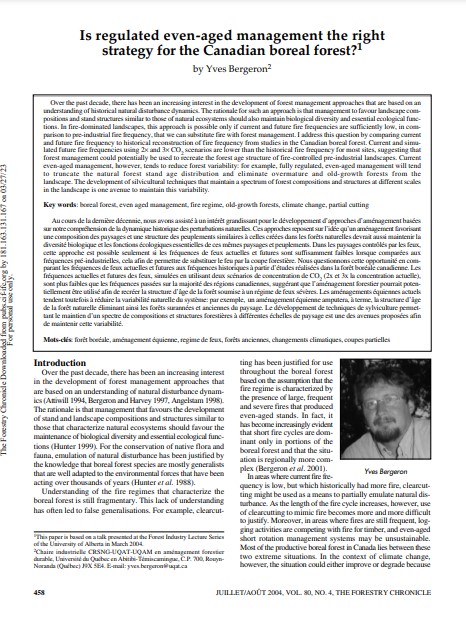Is regulated even-aged management the right strategy for the Canadian boreal forest?
Bosque Modelo:
Lake Abitibi
Temática:
Gestión forestal
Tipo de documento:
Artículo científico
Resumen
Over the past decade, there has been an increasing interest in the development of forest management approaches that are based on an understanding of historical natural disturbance dynamics. The rationale for such an approach is that management to favour landscape compositions and stand structures similar to those of natural ecosystems should also maintain biological diversity and essential ecological functions. In fire-dominated landscapes, this approach is possible only if current and future fire frequencies are sufficiently low, in comparison to pre-industrial fire frequency, that we can substitute fire with forest management. I address this question by comparing current and future fire frequency to historical reconstruction of fire frequency from studies in the Canadian boreal forest. Current and simulated future fire frequencies using 2× and 3× CO2 scenarios are lower than the historical fire frequency for most sites, suggesting that forest management could potentially be used to recreate the forest age structure of fire-controlled pre-industrial landscapes. Current even-aged management, however, tends to reduce forest variability: for example, fully regulated, even-aged management will tend to truncate the natural forest stand age distribution and eliminate overmature and old-growth forests from the landscape. The development of silvicultural techniques that maintain a spectrum of forest compositions and structures at different scales in the landscape is one avenue to maintain this variability.
Información Bibliográfica
Autor:
Bergeron, Y.
Revista:
Forestry Chronicle
Año:
2004
N°:
4
País :
Canadá
Páginas:
458 - 462
Volumen:
80
Idioma:
Ingles
Palabras claves
boreal forest, even aged management, fire regime, old-growth forests, climate change, partial cutting





